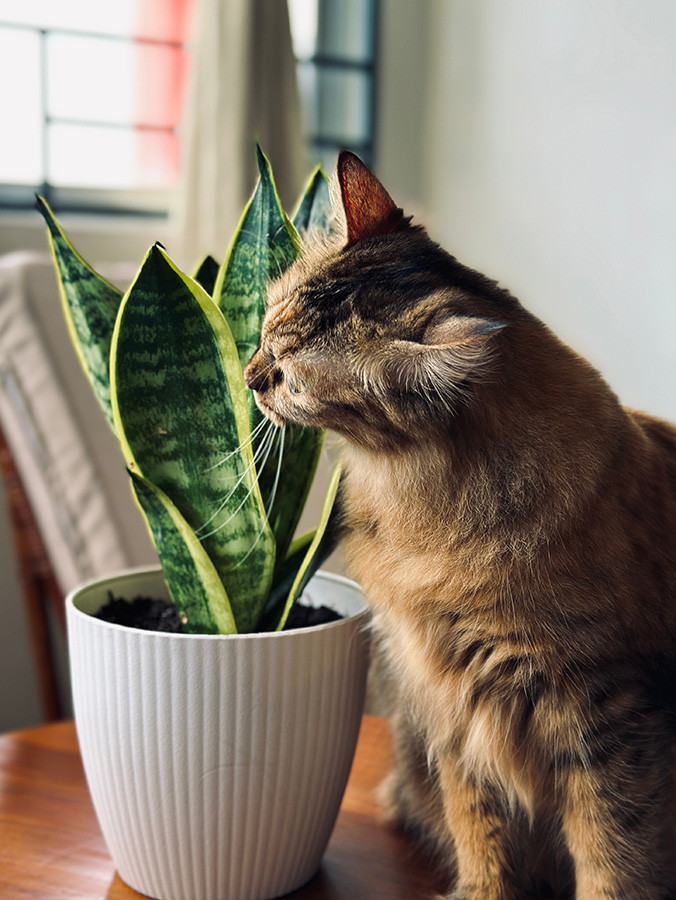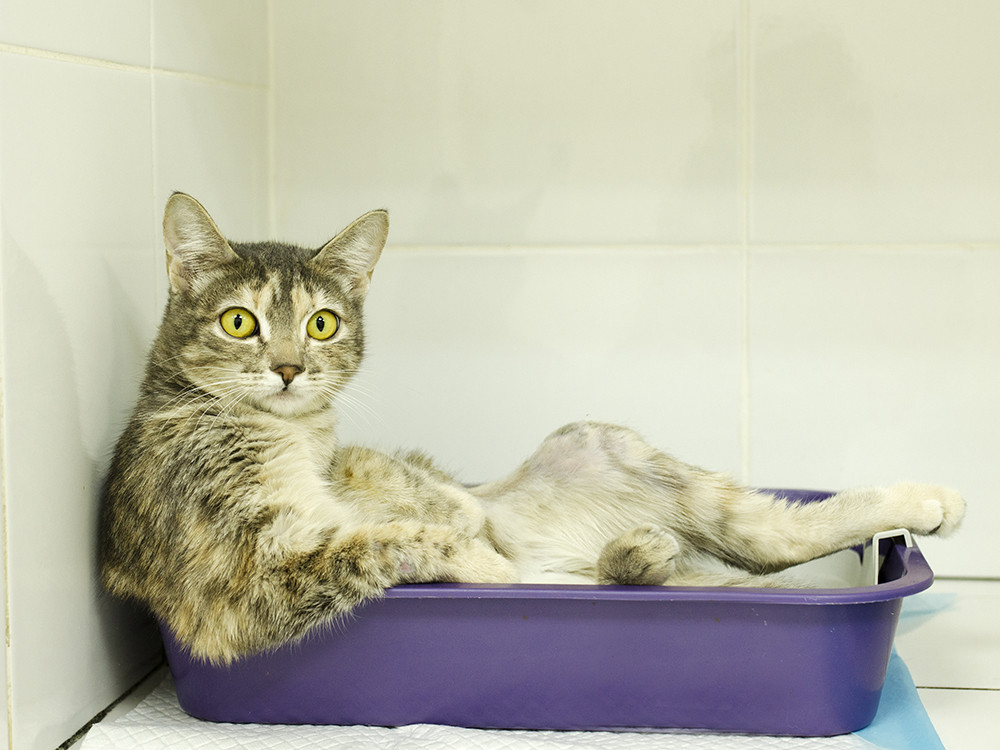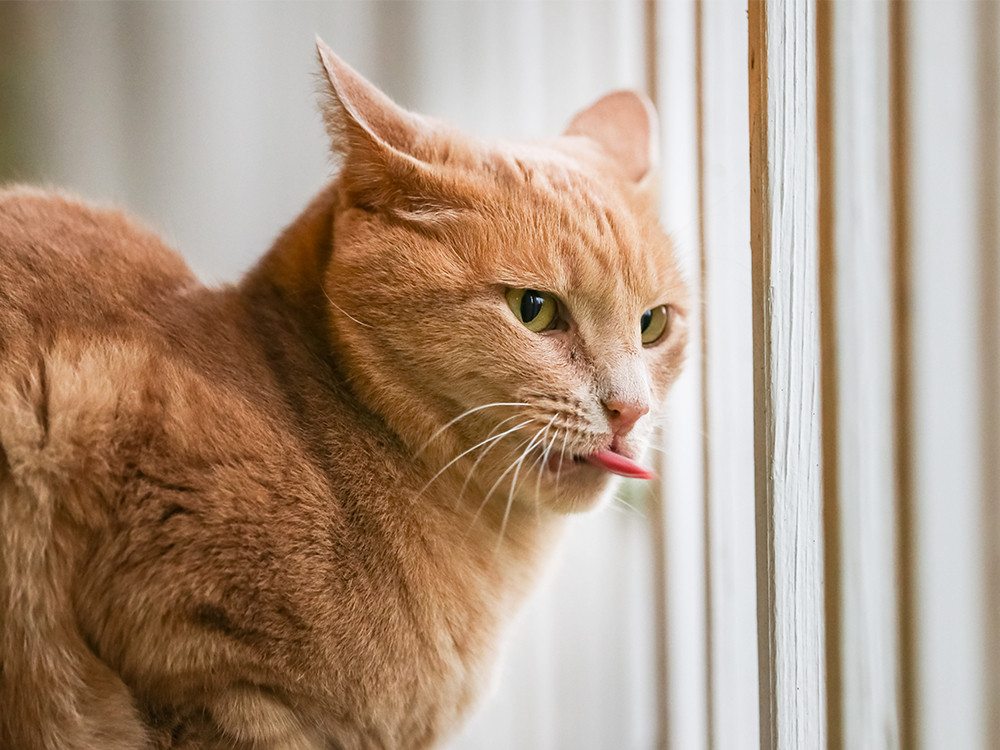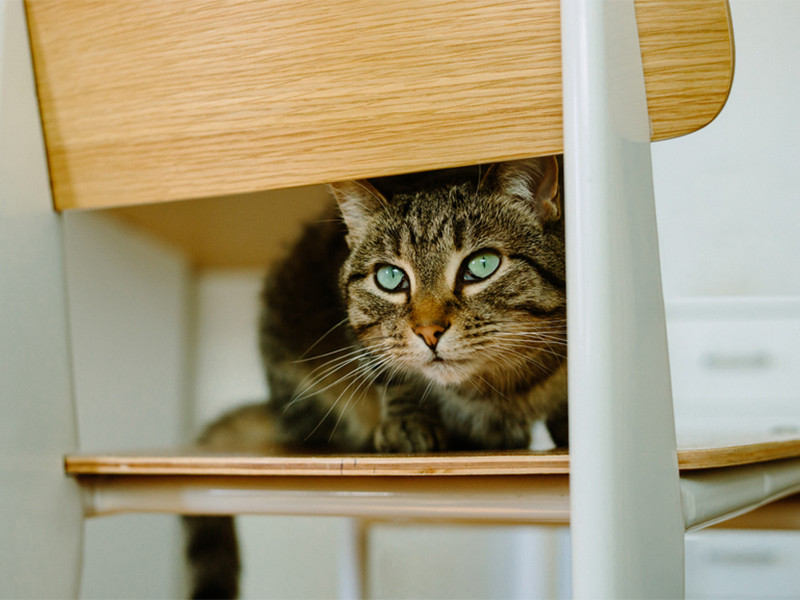Snake plants, also known as Mother-in-Law’s Tongue, are popular choices for indoor greenery due to their resilience and air-purifying qualities. However, if you’re a cat owner, you might be wondering, “Are snake plants toxic to cats?” The answer is yes. While not deadly, snake plants can cause unpleasant symptoms in cats if ingested. Let’s delve into what makes snake plants and cats a potentially bad combination and how to keep your furry friend safe.
 Brown cat curiously sniffing a snake plant in a home setting, highlighting the potential danger of snake plants for cats.
Brown cat curiously sniffing a snake plant in a home setting, highlighting the potential danger of snake plants for cats.
Understanding Snake Plants: Species and Characteristics
Snake plants are native to tropical regions of Africa and Asia and belong to the genus Sansevieria (now Dracaena). Praised for their architectural leaves and air-purifying capabilities, they are a common sight in homes and offices.
Varieties of Snake Plants
With over 70 different species, snake plants exhibit a wide range of appearances. Their leaves can vary dramatically in length, from a compact six inches to an impressive eight feet. Leaf shapes range from slender and cylindrical to broad and flat, often featuring striking variegated patterns in shades of green, yellow, and silver. Common household varieties include Dracaena trifasciata var. laurentii and Dracaena cylindrica ‘Boncel.’
Snake Plant Benefits
- Air Purification: Snake plants are known for their ability to filter indoor air, removing toxins like formaldehyde and carbon monoxide.
- Low Maintenance: These plants are incredibly easy to care for, thriving on neglect. They are drought-tolerant, slow-growing, and adapt well to typical household temperatures and humidity.
- Aesthetic Appeal: The upright, sword-like leaves and diverse color patterns of snake plants make them a stylish addition to any décor.
Snake Plant Drawbacks
- Toxicity: Snake plants are toxic to both cats and humans if ingested.
- Sharp Leaf Tips: The pointed tips of snake plant leaves can be sharp. Broken leaves also cease to grow from the damaged point.
Snake Plant Toxicity in Cats and Pets
Saponins: The Culprit
The toxicity of snake plants comes from compounds called saponins. These naturally occurring chemicals are found throughout the plant and serve as a defense mechanism against pests like insects, fungi, and bacteria. However, when ingested by animals, including cats, saponins can cause significant irritation.
How Snake Plants Harm Cats: Poisonous Components
All parts of the snake plant are poisonous to cats due to the presence of saponins. When a cat chews on or ingests snake plant material, these saponins can irritate the sensitive mucous membranes of the mouth, respiratory system, and gastrointestinal tract. This irritation can lead to a range of symptoms, from mild discomfort to more severe reactions. In more serious cases, certain saponins can disrupt red blood cells by increasing the permeability of their membranes, potentially leading to cell death and, if severe enough, anemia in cats.
 Image related to cat diarrhea, a potential symptom of snake plant poisoning in cats.
Image related to cat diarrhea, a potential symptom of snake plant poisoning in cats.
Recognizing Snake Plant Poisoning in Cats: Symptoms and Actions
Often, cats will only take a small nibble of a snake plant due to its bitter taste and tough texture, resulting in mild symptoms. However, it’s crucial to be vigilant if you suspect your cat has interacted with your snake plant.
Symptoms of Snake Plant Poisoning
Snake plant poisoning in cats is generally considered mild to moderate. The severity of symptoms can vary depending on the amount ingested and the cat’s sensitivity. Common symptoms include:
- Drooling and oral irritation
- Nausea
- Loss of appetite (anorexia)
- Diarrhea
- Vomiting
- Dilated pupils
- Pale gums
- Lethargy or weakness
When to Seek Veterinary Care
If your cat exhibits severe symptoms such as persistent vomiting, bloody diarrhea, weakness, or lethargy, immediate veterinary attention is necessary. Even if symptoms appear mild but you are concerned about the quantity of snake plant consumed, contacting a pet poison control center like ASPCA Animal Poison Control or Pet Poison Helpline is advisable.
Diagnosing and Treating Snake Plant Poisoning
Diagnosing snake plant poisoning can be challenging as vomiting and diarrhea are common symptoms of various feline ailments. Providing your veterinarian with information about your cat’s possible exposure to a snake plant is crucial for accurate diagnosis.
Treatment for snake plant poisoning is typically symptomatic. If veterinary intervention occurs promptly after ingestion, inducing vomiting or administering activated charcoal may be used to minimize toxin absorption. Cats displaying symptoms are treated to manage their specific signs, which may include fluid therapy for dehydration, anti-vomiting medication, and anti-diarrheal medication. Severe cases might require hospitalization for supportive care and monitoring.
 Image related to cat drooling, an early sign of oral irritation from snake plant ingestion in cats.
Image related to cat drooling, an early sign of oral irritation from snake plant ingestion in cats.
Preventing Snake Plant Poisoning: Keeping Cats Safe
The most effective way to protect your cat from snake plant poisoning is to prevent access to the plant altogether. This can be challenging with curious cats who are determined explorers.
Strategies to Deter Cats from Snake Plants
- Remove Snake Plants: The simplest solution is to remove snake plants from your home and opt for cat-safe alternatives.
- Elevate Plants: Place snake plants on high shelves or hanging planters that are completely inaccessible to your cat.
- Cat-Free Zones: Keep snake plants in rooms that your cat cannot access.
- Taste Deterrents: While the bitter saponins might deter some cats, relying on taste alone is not a foolproof method. Cats have individual preferences, and some may still chew on the plant despite the taste.
- Training: Some cats can be trained to avoid certain areas or items. However, this requires consistent effort and may not be effective for all cats, especially when it comes to tempting plants.
Other Plants Toxic to Cats: Awareness is Key
Besides snake plants, numerous other common houseplants are toxic to cats. Being aware of these dangers is essential for creating a safe environment for your feline companion.
- Lilies (True Lilies): Plants in the Lilium genus, including Easter lilies, tiger lilies, and daylilies, are exceptionally dangerous to cats. Ingesting even small amounts can lead to severe kidney failure and potentially be fatal.
- Oleander: All parts of the oleander plant are highly toxic due to cardiac glycosides. Ingestion can cause vomiting, cardiac problems, seizures, and death.
- Poinsettias: Popular during the holiday season, poinsettias contain a sap that can irritate the mouth, skin, eyes, and gastrointestinal tract, causing vomiting and diarrhea.
 Image illustrating cat-proofing a house, relevant to preventing cats from accessing toxic plants like snake plants.
Image illustrating cat-proofing a house, relevant to preventing cats from accessing toxic plants like snake plants.
Cat-Safe Plant Alternatives: Greenery Without the Worry
If you love the look of houseplants but want to ensure your cat’s safety, plenty of beautiful and non-toxic options are available.
- Rattlesnake Plant: Goeppertia insignis (formerly Calathea insignis) offers a similar striking appearance to snake plants and is safe for cats.
- Blushing Bromeliad: Neoregelia carolinae adds vibrant color with its scarlet center and is non-toxic to cats.
- African Violet: Saintpaulia ionantha produces lovely purple flowers and is a safe choice for cat-friendly homes.
Conclusion: Balancing Plants and Pet Safety
While snake plants offer aesthetic and air-purifying benefits, their toxicity to cats makes them a less-than-ideal choice for cat owners. Although snake plant poisoning is usually mild in cats, it can still cause unpleasant symptoms. Prioritizing your cat’s safety means either keeping snake plants completely inaccessible or opting for non-toxic plant alternatives. If you suspect your cat has ingested any part of a snake plant, monitor for symptoms and seek veterinary advice if needed.
Frequently Asked Questions About Snake Plants and Cats
What are the effects if a cat eats a snake plant?
If a cat eats a snake plant, it can experience gastrointestinal upset. Common symptoms include nausea, loss of appetite, diarrhea, and vomiting.
Is it safe for cats to eat snake plants?
No, it is not safe for cats to eat snake plants. They are considered mildly to moderately toxic to cats due to saponins, which are concentrated in the leaves.
Are snake plants poisonous to cats just by smelling them?
Snake plants are not poisonous to cats simply by smelling them. However, allowing cats close enough to smell snake plants also means they have access to potentially ingest them, which should be avoided.
References
 Dr. Chyrle Bonk holds a vet
Dr. Chyrle Bonk holds a vet
Dr. Chyrle Bonk, DVM
Dr. Chyrle Bonk has been practicing as a mixed animal veterinarian since 2010. Beyond her clinical work and writing on veterinary topics, she enjoys outdoor activities with her family and caring for her diverse animal family, including cows, horses, chickens, cats, and dogs.
All articlesopens in a new tab
 alycia washington, dvm
alycia washington, dvm
Dr. Alycia Washington, DVM, MS
Dr. Alycia Washington is a small animal emergency veterinarian in North Carolina. She works as a relief veterinarian, providing services to numerous emergency and specialty veterinary hospitals. Dr. Washington is also a published children’s book author and freelance writer specializing in veterinary medicine. Her passions include turtles, honey bees, and penguins, although her veterinary practice does not extend to them. In her leisure time, Dr. Washington enjoys traveling, culinary experiences, and coffee.
